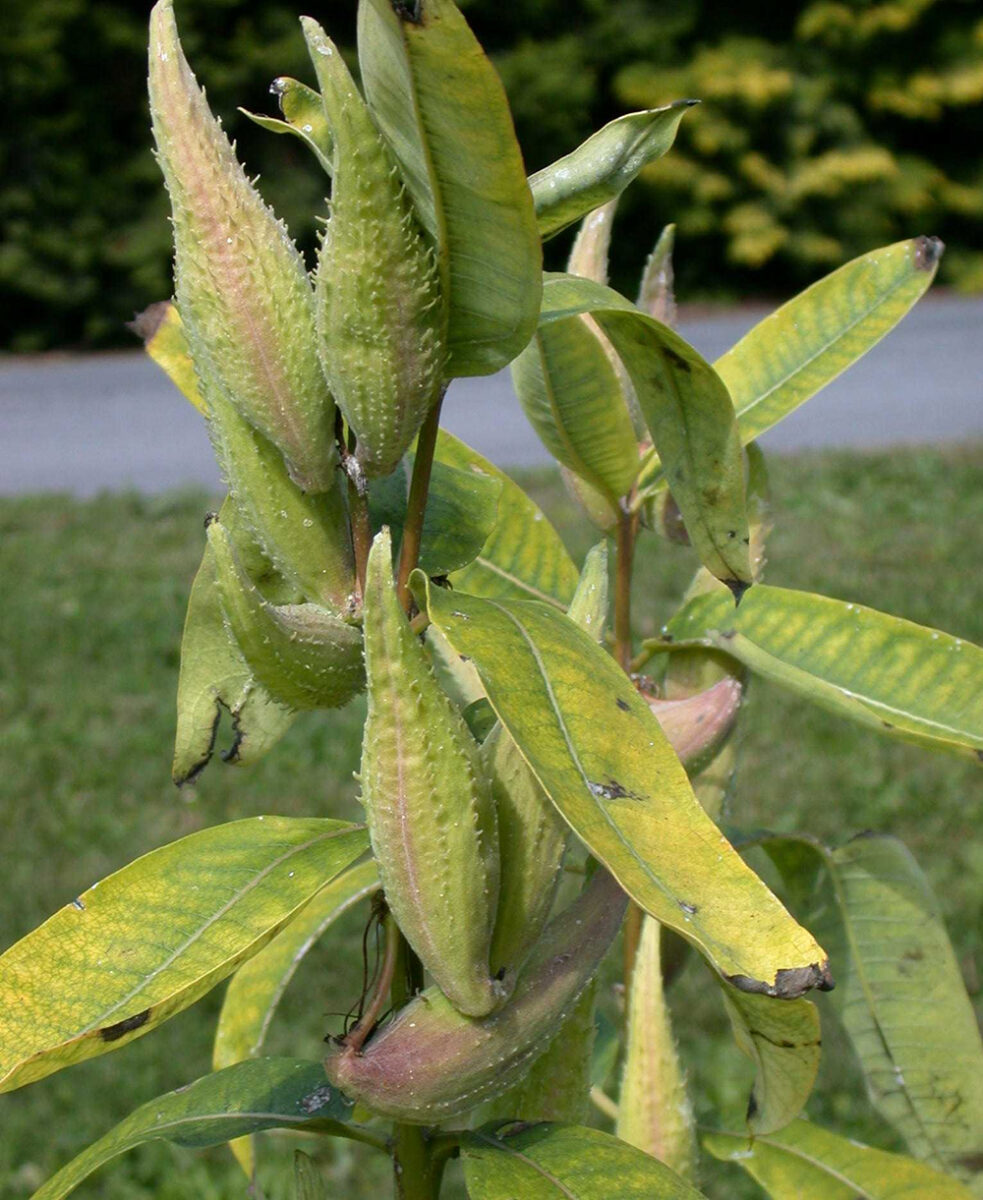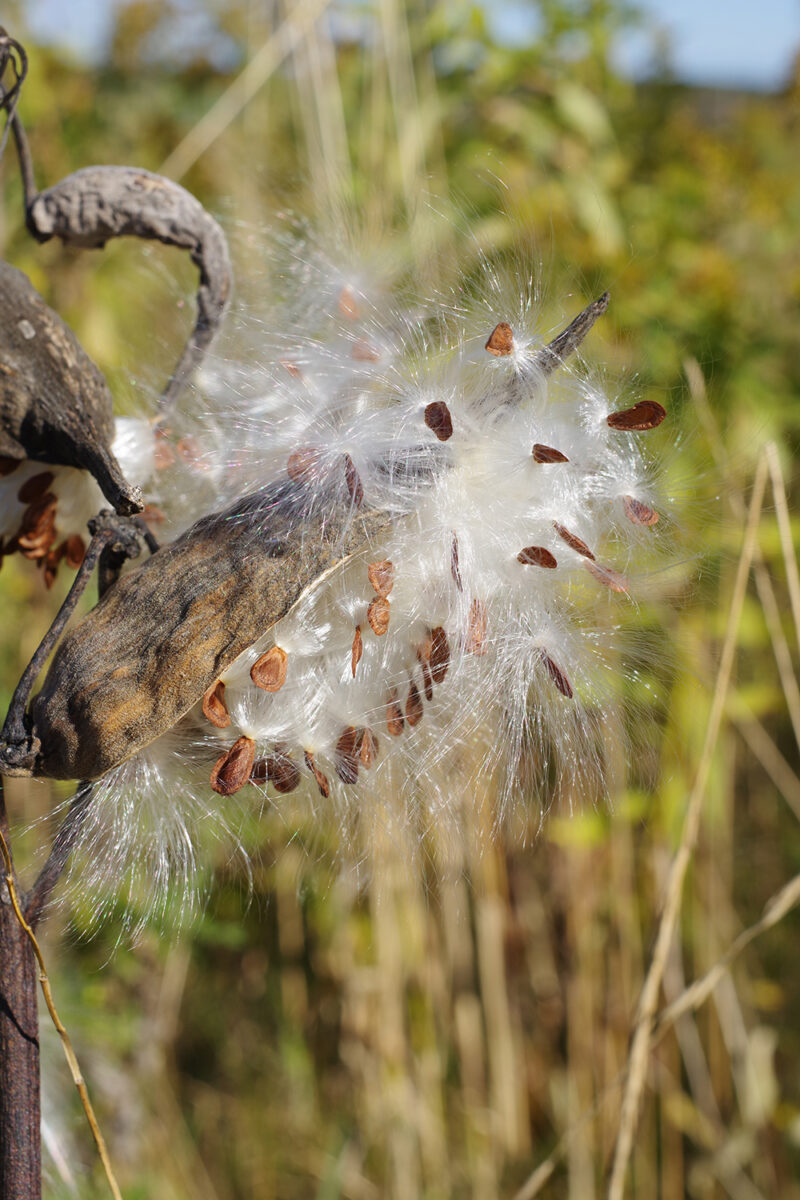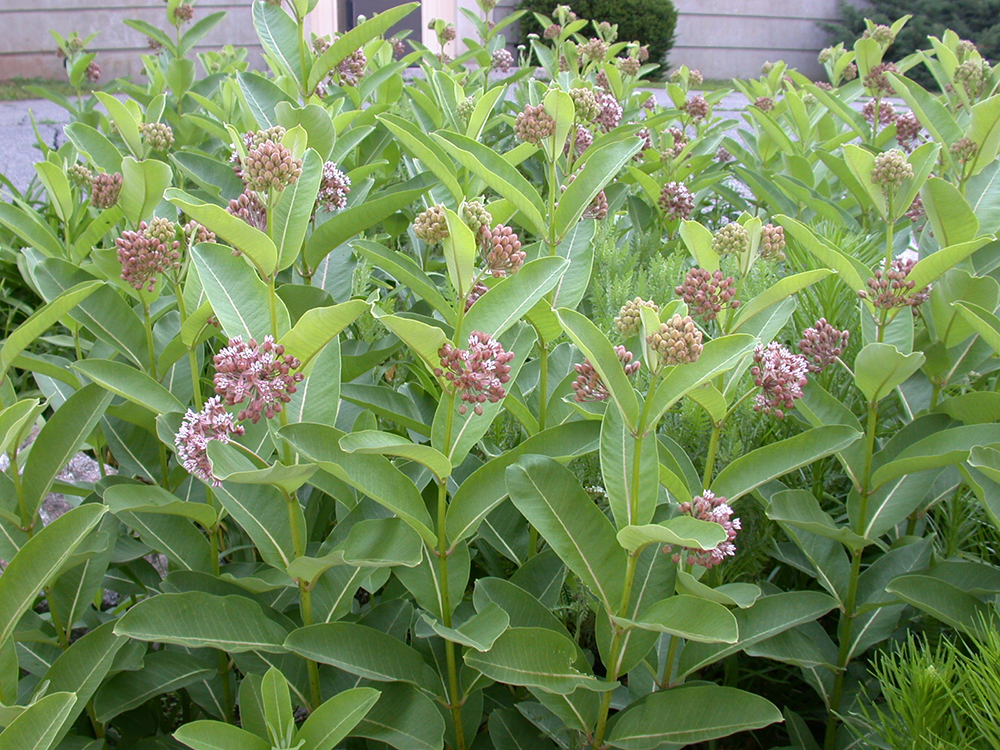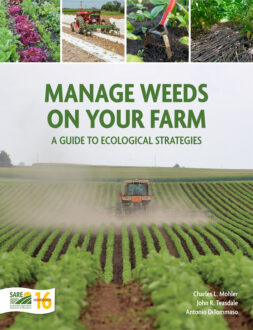Other common names: silkweed, cotton weed, Virginia silk, wild cotton, silky milkweed, common silkweed, showy milkweed, swallow wort



Asclepias syriaca L.
Identification of Milkweed
Family: Milkweed family, Asclepiadaceae
Habit: Erect, unbranched, perennial herb spreading by deep thickened storage roots
Description: Seedlings have light green, smooth stems. Cotyledons are 0.25–0.5 inch long, largely untapered, dull green with prominent veins, long stalks and round tips. True leaves are opposite, waxy, pointy tipped and dark green with a prominent, white midvein. Vegetative sprouts arising from underground roots are far more robust and common than seedlings; sprout stems are capped with a folded clump of leaves that unfolds as the stem elongates. Mature plants reach 3–5 feet tall on a single hollow, hairy, unbranched stem; the stem is green, turning red with maturity. Leaves are opposite and borne upon 0.4 inch-long stalks. The gently tapered, 3–8 inches-long, elliptical leaves are green and hairless on the top, lighter green and hairy on their undersides. Leaf midveins are prominent and white. Secondary veins do not reach the edge of the leaves. The mature plant has a large underground system of thick, white, horizontal storage roots. In deep, well-drained soil, roots can penetrate to 8 feet. The entire plant exudes a white, milky sap when cut. Globes of fragrant, stalked, purple-pink to white flowers grow from upper leaf axils and stem tips. Seeds develop in 3–5 inch-long, teardrop-shaped, bumpy, hairy, spiny, gray-green seedpods; pods tend to grow in pairs. Upon seed maturity, pods split open, shedding up to 200 seeds each, and turn grayish brown. Pod interiors are glossy yellow. Seeds are large, 0.25–0.5 inch, brown, oval with one flat end; the center of the seed is raised and surrounded by a thin, papery margin. Long, silky hairs are attached to the flattened end.
Similar species: Hemp dogbane (Apocynum cannabinum L.) differs from common milkweed by its green-white flowers, branching habit in its upper third, smaller leaves measuring 2–4.5 inches long, and long, narrow, curved seedpods.
Management of Milkweed
Common milkweed does well in grain and early planted corn because the shoots emerge after tillage and planting. In contrast, soil preparation for summer planted crops eliminates the first flush of shoots and forces the plant to use additional root reserves to regenerate shoots. Shoots can emerge from roots well below the plow layer, so a single deep moldboard plowing will not control this weed. Consequently, repeated shallow cultivations that cut shoots before they can replenish the roots are required. For heavy infestations, a tilled fallow period from late spring through summer will help get the weed under control. Carbohydrate storage in the roots reaches a minimum in July to September, so mid-summer fallow may be most effective at exhausting the roots. Buds on the roots become dormant in late summer, however, so fallowing at this time is not effective.
Rotation with alfalfa helps reduce vigor of common milkweed populations due to frequent mowing. Hay crops that are only mowed once per year do not help control this weed. Seedling establishment of common milkweed was highest in spring wheat, intermediate in soybeans and lowest in corn, reflecting the duration of competition throughout the season. Generally, any crop that establishes a leaf canopy before common milkweed emergence and maintains a competitive canopy through the season will greatly suppress this weed.
Common milkweed also serves several beneficial functions within agroecosystems. It hosts aphids that provide a food source for parasitic wasps, which, in turn, attack and control the European corn borer (Ostrinia nubilalis). It also contains compounds that support reproduction and survival of the monarch butterfly (Danaus plexippus) during their migration to overwintering sites in Mexico. Consequently, maintenance of low milkweed densities in crop fields may contribute to a balanced landscape management strategy that realizes the ecological benefits of common milkweed while avoiding its agricultural liabilities.
Ecology of Milkweed
Origin and distribution: Common milkweed is native to eastern North America and occurs from Georgia to Oklahoma, northward to southern Canada. It has been introduced into Europe and Japan, and the Willamette Valley of Oregon.
Seed weight: Mean seed weights for various populations range from 3.5–7.4 mg.
Dormancy and germination: Seeds are dormant when shed from the mother plant and require one to nine weeks of cold (41–48°F), wet conditions or about one year of dry storage to break dormancy. The longer the exposure to cold conditions, the lower the temperature required for optimum germination. This ensures that seeds will not germinate when shed in the fall but will be ready for germination the spring following dispersal. Seeds germinate at constant temperatures from 59–95°F, but germination is best at fluctuating day/night temperatures from 68/50°F to 95/68°F. Seed germination percentage increases in the presence of nitrate. Light has little influence on germination of cold stratified seeds. Optimum pH for germination is 4–8.
Seed longevity: Seeds survive in the soil for up to nine years, but most seeds will probably germinate or die within the first three years following production.
Season of emergence: Seedlings emerge primarily in the spring. Optimum temperature for emergence was 81°F with minimal emergence at temperatures below 59°F. Shoots from overwintering rootstocks emerge from mid-spring throughout the summer, but peak emergence occurs in late spring and early summer.
Emergence depth: Seeds germinate poorly on the soil surface, but seedlings emerge well from 0.2–1.6 inch. A few seedlings can emerge from 2.4–2.8 inches. New shoots can emerge from rootstocks buried as deep as 3.5 feet in the soil, but most emerge from roots in the top 12 inches.
Photosynthetic pathway: C3
Sensitivity to frost: Common milkweed seedlings and shoots normally do not emerge until after the last frost, and the shoots usually begin to die back prior to the first frost in the fall, so frost has little consequence for this species. This species was entirely killed when present at the first frost in the fall.
Drought tolerance: Full grown plants are drought tolerant because of their deep taproot, but seedlings are more drought sensitive than other weed species.
Mycorrhiza: Common milkweed had a low mycorrhizal status in prairie settings. Low levels of infection by one mycorrhizal species increased milkweed biomass, but infection by another species decreased biomass.
Response to fertility: Common milkweed grows well on soils with relatively low nitrogen, but plant size responds to balanced fertilization with N, P and K. More biomass is allocated to roots than to shoots under low fertility conditions than under high fertility conditions. Reproductive pod and seed output is also increased by a balanced fertilizer. It tolerates pH from 4–10 but does best on slightly alkaline soils.
Soil physical requirements: The species does not tolerate wet soils. It thrives on soils with a wide range of textures provided drainage is adequate. It appears to tolerate compaction given its common occurrence on headlands and roadsides. It tolerates salt and can grow at substantially higher salt concentrations than sorghum. It is absent from boron deficient soils.
Response to shade: Common milkweed grows best in 30–100% of full sunlight. Mid-summer shading of 75% had little effect on pod and seed production. Shade from a dense annual weed leaf canopy in the absence of soil competition substantially reduced reproduction of common milkweed roots.
Sensitivity to disturbance: The roots of mature plants can penetrate 7–12 feet into the soil, and root fragments from as deep as 4–5 feet are capable of resprouting. This regeneration capacity protects them from damage during tillage and cultivation. Seedling roots develop buds about three weeks after emergence that are capable of regenerating a new shoot if the original is destroyed. Plants in the three-leaf stage are capable of 65% resprouting when clipped at ground level, and plants in the four-leaf stage or greater are capable of 100% resprouting with multiple shoots. Thus, only occasional mowing or tillage will not prevent the development of a large colony.
Time from emergence to reproduction: Seedlings do not flower the first year. Shoots from older plants flower roughly six to eight weeks after emergence. Seeds mature about six weeks after flowering. In Missouri, plants reached peak pod production in late July/early August, and pods dried and opened by the end of September.
Pollination: Common milkweed is self-sterile and cross pollinated by insects, mostly bees and wasps. Bumblebees are primarily responsible for pollination by day, but moths pollinate at night. The majority of pollinated flowers abort, with very few producing mature seedpods.
Reproduction: Stalks typically produce four to six pods, each containing 100–425 seeds. The number of pods depends on the level of pollination. Normally, vegetative reproduction does not begin until the second or third year of life. An undisturbed plant in southern Ontario produced a colony of 56 shoots during its fourth growing season.
Dispersal: Seeds are dispersed primarily by wind. Each seed has a tuft of fine, silky hairs that provide buoyancy in the air. Seeds often cling to the pods for several months after the pods open, which prolongs the period of dispersal into late winter. Root growth can spread the plant up to 10 feet per year. Root fragments are dispersed within fields and occasionally between fields on tillage implements. Root segments as small as 1 inch can produce shoots.
Common natural enemies: Common milkweed flowers can be destroyed by the mid-summer herbivores Tetraopes tetrophthalmus and Diabrotica cristata, while pods are destroyed in late summer by T. tetrophthalmus, Rhysseratus lineaticollis and Oncopeltus fasciatus. It hosts several specialized insects including caterpillars of the monarch butterfly (Danaus plexippus), the milkweed longhorned beetle (Tetraopes teraophtalmus) and the small milkweed bug (Lygaeus kalmii), but they usually do little to control the weed. Virus diseases cause yellowing or mottling, clumping of stems, and deformed stems and leaves.
Palatability: Milky sap contains a poison that causes nausea and potential heart damage. Nevertheless, young shoots, buds and flowers can be used as a pot herb provided the water is changed repeatedly during cooking to remove the bitter sap. Common milkweed is poisonous to livestock when 1–2% of body weight is consumed, but toxicity decreases as plants mature. Dried milkweed in hay remains toxic.
Note: Common milkweed appears to contain allelopathic compounds that inhibit the growth of selected crops and weeds.
Summary Table for Milkweed Characteristics
| Common milkweed | ||||||||
|---|---|---|---|---|---|---|---|---|
| Growth habit | Perennial overwinter organ | Emergence period from perennial organs | Optimum emergence depth (inches) from perennial organs | Time/stage of lowest reserves | Photosynthesis Type | Frost tolerance | Drought tolerance | Mycorrhiza |
| medium, erect | thickened roots | late spring to early summer | 1–12 | mid-summer | C3 | low | high | yes |
| Fertility response | Importance of seeds to weediness | Seed weight (mg) | Dormancy of shed seeds | Factors breaking dormancy | Optimum temperarature range (F) for seed germination | Seedling emergence period | Emergence to flowering (weeks) | |
| moderate | moderate | 3.5–7.4 | yes | cms, at, ni | 68/50 to 95/68 | spring | 6–8 | |
Table Key
Drought tolerance: Relative tolerance of aboveground plants to drought (high, moderate, low).
Emergence period from perennial organs: Time of year when most emergence occurs from perennial overwintering organs in the typical regions of occurrence for each weed. Some emergence may occur outside of this range.
Emergence to flowering: Length of time (weeks) after emergence from perennial organs to the beginning of flowering in the typical regions of occurrence. Note that this refers to established perennial plants, recognizing that some species may not flower in their initial year of establishment.
Factors breaking dormancy: The principle factors that are reported to break dormancy and facilitate germination. The order of listing does not imply order of importance. Abbreviations are:
- scd = seed coat deterioration
- cms = a period subjected to cold, moist conditions
- wst = warm soil temperature
- li = light
- at = alternating day-night temperatures
- ni = nitrates
Flowering to viable seed: Length of time (weeks) after flowering for seeds to become viable.
Frost tolerance: Relative tolerance of aboveground shoots to freezing temperatures (high, moderate, low).
General: The designation "-" signifies that data is not available or the category is not applicable.
Growth habit: A two-word description. The first word indicates relative height (tall, medium, short, prostrate) and the second word indicates degree of branching (erect, branching, vining).
Importance of seeds to weediness: The relative importance of seeds to dispersal, genetic diversity and survival of the species as a weed in agricultural environments (high, moderate, low).
Mycorrhiza: Presence of mycorrhizal fungi. “Yes” if present; “no” if documented not to be present, “unclear” if there are reports of both presence and absence; “variable” if the weed can function either with or without, depending on the soil environment.
Optimum emergence depth from perennial organs: Soil depths (in inches below the soil surface) from which most shoots emerge from perennial organs. Lower rates of emergence usually will occur at depths above or below this range.
Optimum temperature range for germination: Temperature (Fahrenheit) range that provides for optimum germination of non-dormant seeds. Germination at lower percentages can occur outside of this range. The dash refers to temperature range, and the slash refers to alternating day/night temperature amplitudes.
Perennial overwinter organ: Principal plant organ that survives winter and from which growth resumes in subsequent years.
Photosynthesis type: Codes “C3” or “C4” refer to the metabolic pathway for fixing carbon dioxide during photosynthesis. Generally, C3 plants function better in cooler seasons or environments and C4 plants function better in warmer seasons or environments.
Pollination: “Self” refers to species that exclusively self-pollinate; “cross” refers to species that exclusively cross-pollinate; “self, can cross” refer to species that primarily self-pollinate, but also cross-pollinate at a low rate; and “both” refers to species that both self-pollinate and cross pollinate at relatively similar rates.
Response to nutrients: Relative plant growth response to the nutrient content of soil, primarily N, P, K (high, moderate, low).
Seed dormancy at shedding: “Yes” if most seeds are dormant when shed; “Variable” if dormancy is highly variable; “No” if most seeds are not dormant.
Seed mortality in tilled soil: Range of mortality estimates (percentage of seed mortality in one year) for seeds in tilled soil. Values were chosen for seeds placed within the tillage depth and subjected to at least annual tillage events. Seed losses are the result of dormancy-breaking cues induced by tillage, germination and deterioration of un-germinated seeds.
Seed mortality in untilled soil: Range of mortality estimates (percentage of seed mortality in one year) for buried seeds in untilled soil. Values were chosen where possible for seeds placed at depths below the emergence depth for the species and left undisturbed until assessment. Mortality primarily represents seed deterioration in soil.
Seed weight: Range of reported values in units of “mg per seed."
Time/stage of lowest reserves: Time of year and/or weed growth stage at which carbohydrate reserves are lowest. This usually corresponds to the time when the weed is most susceptible to weed management operations.
Typical and high seed production potential: The first value is seed production (seeds per plant) under typical conditions with crop and weed competition. The second value, high seed production, refers to conditions of low density without crop competition. Numbers are rounded off to a magnitude that is representative of often highly variable reported values.
Typical emergence season: Time of year when most emergence occurs in the typical regions of occurrence for each weed. Some emergence may occur outside of this range.
Weed: Weed common name as listed in the Weed Science Society of America Composite List of Weeds, presented in alphabetical order.
Further Reading
Bhowmik, P.D. 1994. Biology and control of common milkweed (Asclepias syriaca). Reviews of Weed Science 6: 227–250.
DiTommaso, A., K.M. Averill, M.P. Hoffman, J.R. Fuchsberg, and J.E. Losey. 2016. Integrating insect, resistance, and floral resource management in weed control decision-making. Weed Science 64: 743–756.
Evetts, L.L. and O.C. Burnside. 1975. Effect of competition on growth of common milkweed. Weed Science 23: 1–3.

